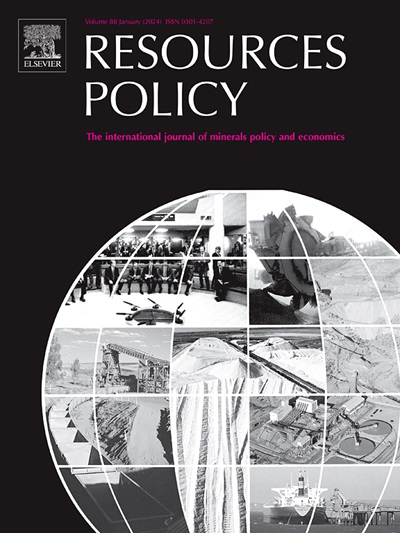采矿业采用循环经济实践:来自智利的证据
IF 10.2
2区 经济学
0 ENVIRONMENTAL STUDIES
引用次数: 0
摘要
本文探讨了采矿业采用循环经济(CE)的做法。大规模采矿对全球材料供应和能源转型至关重要,但也带来了重大的环境挑战。采用环保策略和实践可以通过减少浪费、提高资源效率和减少对环境的影响来帮助缓解这些挑战。然而,现有的节能框架主要集中在下游价值链环节,缺乏关键的概念要素来指导采矿业等上游行业的节能应用。该研究通过确定现有环保框架中缺失的三个关键概念要素,推进了关于环保、负责任的矿物采购和可持续原材料开采的文献:(1)对采用环保实践所针对的工业生产系统的目标和边界的清晰沟通;(2)系统所使用输入的来源和类型的识别;(3)考虑这些投入物的资源状态以及由此产生的结构性浪费。这些新的概念要素允许对采矿业的环境进行系统级的环境管理采用分析。该研究以智利为例,说明了如何将这种新的概念方法应用于规划采矿部门现有的环境行政实践和战略。调查结果显示,智利的铜和锂矿业公司成功地采用了环保实践,例如在矿石加工、尾矿的开采和再利用以及采矿机械的再制造中使用海水。这表明采矿业有很大的潜力采用环保思维。然而,该案例研究也强调了在设计节能实践时普遍缺乏系统思考和附加性的趋势,这给该行业大规模采用节能实践带来了重大挑战。本文章由计算机程序翻译,如有差异,请以英文原文为准。

Adoption of circular economy practices in the mining sector: Evidence from Chile
This paper explores the adoption of Circular Economy (CE) practices in the mining sector. Large-scale mining is essential for global material supply and the energy transition but poses significant environmental challenges. Adopting CE strategies and practices can help mitigate these challenges by reducing waste, improving resource efficiency, and minimising environmental impacts. However, existing CE frameworks are focused on downstream value chain segments and lack crucial conceptual elements to guide CE adoption in upstream industries like mining. The study advances the literature on CE, responsible sourcing of minerals and sustainable raw material extraction by identifying three crucial conceptual elements missing from existing CE frameworks: (1) a clear communication of the goal and boundary of the industrial production system that the adoption of CE practices is targeting; (2) an identification of the source and type of inputs used by the system; and (3) a consideration of the resource state of these inputs and the subsequent structural wastes generated from them. These new conceptual elements allow for a system-level analysis of CE adoption tailored to the context of the mining industry.
Using the case of Chile, the study demonstrates how this new conceptual approach can be applied to map existing CE practices and strategies used in the mining sector. Findings reveal that Chilean copper and lithium mining companies are successfully adopting CE practices, such as using seawater in ore processing, remining and repurposing tailings, and remanufacturing mining machinery. This shows that there is significant potential for the mining industry to adopt CE thinking. However, the case study also highlights prevalent tendencies of a lack of systems thinking and additionality in the design of CE practices, which present significant challenges for the sector to adopt CE practices at scale.
求助全文
通过发布文献求助,成功后即可免费获取论文全文。
去求助
来源期刊

Resources Policy
ENVIRONMENTAL STUDIES-
CiteScore
13.40
自引率
23.50%
发文量
602
审稿时长
69 days
期刊介绍:
Resources Policy is an international journal focused on the economics and policy aspects of mineral and fossil fuel extraction, production, and utilization. It targets individuals in academia, government, and industry. The journal seeks original research submissions analyzing public policy, economics, social science, geography, and finance in the fields of mining, non-fuel minerals, energy minerals, fossil fuels, and metals. Mineral economics topics covered include mineral market analysis, price analysis, project evaluation, mining and sustainable development, mineral resource rents, resource curse, mineral wealth and corruption, mineral taxation and regulation, strategic minerals and their supply, and the impact of mineral development on local communities and indigenous populations. The journal specifically excludes papers with agriculture, forestry, or fisheries as their primary focus.
 求助内容:
求助内容: 应助结果提醒方式:
应助结果提醒方式:


